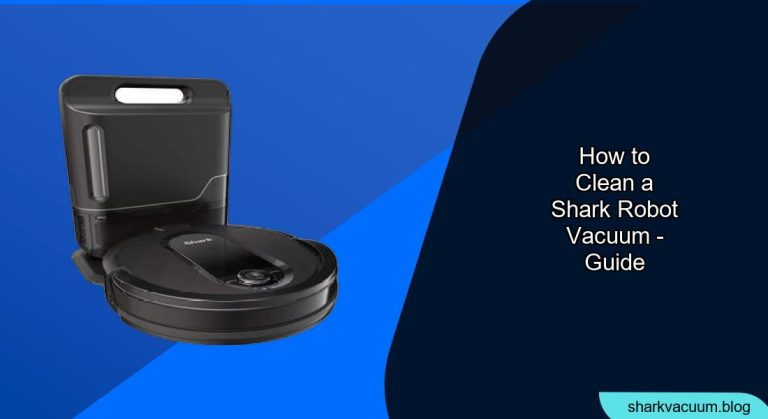Robot vacuums are a convenient way to keep your floors clean, but they require regular maintenance to function optimally. This guide will walk you through the process of cleaning your Shark robot vacuum, ensuring it continues to provide efficient and reliable cleaning for your home. Maintaining your Shark robot vacuum properly will extend its lifespan and improve its cleaning performance.
Table of Contents
Why Cleaning Your Shark Robot Vacuum Matters
A dirty robot vacuum can quickly lose its cleaning power. Dust, hair, and debris can clog the brushes, sensors, and filters, reducing suction and overall effectiveness. Regular cleaning prevents these issues, ensuring your Shark robot vacuum continues to operate at its best. Neglecting maintenance can lead to decreased performance and potentially damage the unit over time.
This guide provides step-by-step instructions to help you keep your Shark robot vacuum in top condition. We’ll cover everything from emptying the dustbin to cleaning the brushes and sensors.
Tools and Materials You’ll Need
Before you begin, gather the following tools and materials:
- Soft-bristled brush (often included with the vacuum)
- Microfiber cloth
- Small scissors or seam ripper
- Vacuum cleaner with hose attachment (optional)
- Mild dish soap (optional)
- Water
Step-by-Step Guide to Cleaning Your Shark Robot Vacuum
Follow these steps to thoroughly clean your Shark robot vacuum:
1. Empty the Dustbin
The dustbin should be emptied after each use or at least once a week, depending on how often you use your robot vacuum and how much debris it collects.
- Remove the Dustbin: Locate the dustbin release button or latch on your Shark robot vacuum. Press the button or release the latch to remove the dustbin.
- Empty the Contents: Hold the dustbin over a trash can and open the lid or release the bottom flap to empty the contents. Tap the dustbin gently to dislodge any stuck debris.
- Clean the Dustbin: Rinse the dustbin with water and mild dish soap, if necessary. Ensure it is completely dry before reattaching it to the robot vacuum. A damp dustbin can cause mold or mildew growth.
2. Clean the Main Brush Roll
The main brush roll is responsible for agitating and lifting dirt from your floors. It can easily become tangled with hair and fibers, reducing its effectiveness.
- Remove the Brush Roll: Locate the brush roll access panel on the bottom of your Shark robot vacuum. Remove the screws or release the latches to open the panel.
- Remove Debris: Use your fingers, small scissors, or a seam ripper to carefully remove any hair, string, or debris wrapped around the brush roll.
- Clean the Brush Roll: Wipe the brush roll with a clean, dry microfiber cloth. If necessary, you can rinse it with water, but ensure it is completely dry before reinstalling it.
- Reinstall the Brush Roll: Place the cleaned brush roll back into its housing and secure the access panel.
3. Clean the Side Brushes
The side brushes help sweep dirt and debris into the path of the main brush roll. They can also accumulate dust and hair, so regular cleaning is essential.
- Remove the Side Brushes: Gently pull the side brushes straight off the robot vacuum. They are usually attached with a simple friction fit.
- Remove Debris: Remove any hair or debris tangled around the base of the brushes.
- Clean the Brushes: Wipe the brushes with a damp microfiber cloth. If they are particularly dirty, you can rinse them with water and mild dish soap, ensuring they are completely dry before reattaching them.
- Reinstall the Side Brushes: Press the cleaned side brushes back onto their posts until they click into place.
4. Clean the Filters
The filters trap dust and allergens, preventing them from being recirculated into your home. Cleaning them regularly helps maintain optimal suction and air quality.
- Locate the Filter(s): The filter(s) are usually located near the dustbin. Refer to your robot vacuum’s user manual for the exact location.
- Remove the Filter(s): Remove the filter(s) from the robot vacuum.
- Clean the Filter(s): Gently tap the filter(s) over a trash can to remove loose dust and debris. You can also use a vacuum cleaner with a hose attachment to clean the filter(s). Some filters are washable; if yours is, rinse it with water and allow it to air dry completely before reinstalling. Never reinstall a damp filter.
- Reinstall the Filter(s): Place the cleaned filter(s) back into their housing.
5. Clean the Sensors
The sensors help your robot vacuum navigate your home and avoid obstacles. Dirty sensors can cause erratic behavior and prevent the vacuum from cleaning effectively.
- Locate the Sensors: The sensors are usually located on the bottom and front of the robot vacuum.
- Clean the Sensors: Use a clean, dry microfiber cloth to gently wipe the sensors. Avoid using any liquids or abrasive cleaners, as they can damage the sensors.
6. Wipe Down the Exterior
Finally, wipe down the exterior of your Shark robot vacuum to remove any dust or grime.
- Dampen a Microfiber Cloth: Lightly dampen a microfiber cloth with water.
- Wipe the Exterior: Wipe down the entire exterior of the robot vacuum, paying attention to areas that may have accumulated dust or dirt.
- Dry the Exterior: Use a dry microfiber cloth to dry the exterior of the robot vacuum.
Troubleshooting Guide
Here are some common issues you might encounter and how to resolve them:
- Robot vacuum not picking up dirt:
- Cause: Clogged brush roll or full dustbin.
- Solution: Clean the brush roll and empty the dustbin.
- Robot vacuum not navigating properly:
- Cause: Dirty sensors.
- Solution: Clean the sensors with a dry microfiber cloth.
- Reduced suction power:
- Cause: Clogged filters.
- Solution: Clean or replace the filters.
- Robot vacuum stops running:
- Cause: Low battery or obstruction.
- Solution: Charge the battery or remove any obstructions.
- Side brushes not spinning:
- Cause: Tangled debris.
- Solution: Clean the side brushes and remove any obstructions.
Pro Tips for Maintaining Your Shark Robot Vacuum
- Regular Cleaning Schedule: Establish a regular cleaning schedule to prevent buildup and maintain optimal performance.
- Monitor Brush Roll: Regularly check the brush roll for tangled hair and debris.
- Replace Filters: Replace the filters every few months, depending on usage.
- Keep Charging Contacts Clean: Ensure the charging contacts on the robot vacuum and charging base are clean for efficient charging.
- Clear Obstacles: Before running the robot vacuum, clear any small objects or cords that could get tangled in the brushes.
FAQ Section
What is the best way to clean the HEPA filter on my Shark robot vacuum?
The best way to clean a HEPA filter is to gently tap it over a trash can to remove loose debris. You can also use a vacuum cleaner with a hose attachment to carefully vacuum the filter. Some HEPA filters are washable, but always check the manufacturer’s instructions before washing, and ensure it’s completely dry before reinstalling.
How often should I replace the brush roll on my Shark robot vacuum?
You should replace the brush roll every 6-12 months, depending on usage and the amount of debris it encounters. If you notice the brush roll is worn or damaged, or if it’s not cleaning as effectively, it’s time to replace it.
Can I use cleaning solutions on the sensors of my Shark robot vacuum?
No, you should never use cleaning solutions on the sensors. Use only a clean, dry microfiber cloth to gently wipe the sensors. Cleaning solutions can damage the sensors and affect their performance.
What do I do if my Shark robot vacuum is making strange noises?
Strange noises can indicate a problem with the brush roll, motor, or other components. First, check the brush roll for any tangled debris or obstructions. If the noise persists, contact Shark customer support for further assistance.
How can I prevent my Shark robot vacuum from getting stuck?
To prevent your Shark robot vacuum from getting stuck, clear any small objects, cords, or loose rugs from the floor before running it. You can also use virtual boundaries or magnetic strips to block off areas where the robot vacuum is likely to get stuck.
Is it necessary to clean the wheels of my Shark robot vacuum?
Yes, it is important to clean the wheels of your Shark robot vacuum periodically. Dust, hair, and debris can accumulate around the wheels, affecting their ability to move smoothly. Use a damp cloth to wipe the wheels and remove any buildup.
Tips, Warnings, and Best Practices
- Safety First: Always turn off the robot vacuum before cleaning it.
- Avoid Water Damage: Never submerge the robot vacuum in water.
- Read the Manual: Refer to your robot vacuum’s user manual for specific cleaning instructions and maintenance recommendations.
- Regular Maintenance: Consistent cleaning and maintenance will prolong the life of your robot vacuum and ensure optimal performance.
- Use Genuine Replacement Parts: When replacing parts, use genuine Shark replacement parts to ensure compatibility and performance.
Conclusion
Cleaning your Shark robot vacuum is essential for maintaining its performance and extending its lifespan. By following this comprehensive guide, you can keep your robot vacuum in top condition, ensuring it continues to provide efficient and reliable cleaning for your home. Make regular cleaning a part of your routine to enjoy a cleaner home with less effort.
Consider setting a reminder to clean your Shark robot vacuum weekly to maintain optimal performance.







